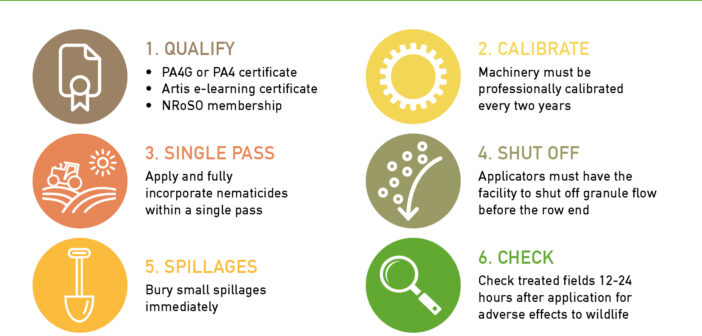The Nematicide Stewardship Programme (NSP) reminds potato growers to follow the best practice granular nematicide protocol this spring to ensure products are used safely and are protected for the future. Simon Alexander, potato agronomist and working group member of the Nematicide Stewardship Programme (NSP), explains the importance of the issue.
“Granular nematicides remain a vital tool for use as part of an integrated strategy to control nematodes,” he says.
“These are microscopic parasitic roundworms which live in the soil and feed on the roots of crops that are reported to cost the potato industry £50m in damage every year according to 2018 AHDB data.
“The NSP best practice brings together practical advice and forms part of the Red Tractor standard for growers,” adds Mr Alexander.
He outlines the six key areas of the protocol.Qualify
All operators must have a PA4 or PA4G certification and must have completed the ARTIS Nematicide Stewardship e-learning course to apply granular nematicides. They must also be members of NRoSO
Calibrate
Applicators must be checked daily for damage or wear, to ensure all pipework is correctly fitted. The applicator must be inspected and certified as fit for use by a qualified National Sprayer Testing Scheme (NSTS) engineer at least every two years. The amount of product used should be calculated according to the area treated to make sure the correct volume per hectare is applied. Single pass
The product should be incorporated within a single pass, immediately prior to planting with no granules left on the surface of the soil. Shut off
All applicators must be fitted with a device in the cab that allows operators to shut off granule flow at least 3 metres from the end of each row. The shut off time allows for all piping to run out before the machine is lifted out of the ground.
Spillages
Use the same filling point in the field to allow any spillages to be identified quickly. Bury small spillages immediately to ensure no granules are left on the surface. If the spillage is large, remove it to an empty nematicide container, clearly label it and return it to the manufacturer, burying any remnants immediately.
Check
Check treated fields 12 to 24 hours after application for adverse effects to wildlife. Check field edges and areas where application equipment is turned on and off, but also inside headlands and breaks in the middle of the field.
For more information, growers are urged to visit the NSP website to update their knowledge on best practice application of granular nematicides before planting – Code of good practice for the application of nematicides (nspstewardship.co.uk)




